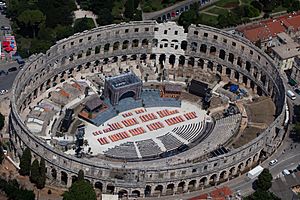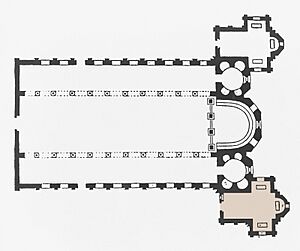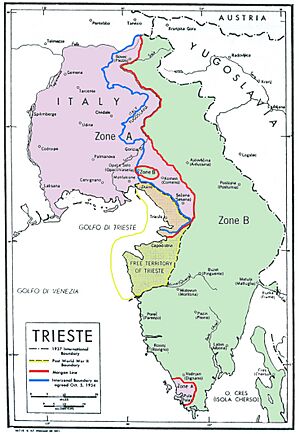History of Istria facts for kids
Istria is the largest peninsula in the Adriatic Sea. It's located at the top of the Adriatic, between the Gulf of Trieste and the Bay of Kvarner. Today, Istria is shared by three countries: Croatia, Slovenia, and Italy. People speak Croatian, Slovene, and Italian here.
Contents
Ancient Times in Istria
Early Humans and Tribes
The first signs of human life in Istria go way back to the Lower Paleolithic period. Scientists found tools and other items in Šandalja Cave near Pula that are about 800,000 years old!
Around 1100 BC, a tribe called the Histri settled in Istria. The peninsula is actually named after them! Their arrival marked the start of the Iron Age in this area. Another important tribe living nearby was the Liburnians, whose land stretched east of the Raša River.
Roman Rule and Influence
After some battles, the Romans took control of the Istrian peninsula in 178 and 177 BC. They built the important port city of Pietas Iulia, which is now Pula. They also started large farms called latifundia in the inland areas.
Even though some local tribes resisted, the Romans eventually became the masters of Istria. Pula still has amazing Roman buildings like its Forum and the famous Amphitheater. Most of Istria's main towns were founded during this Roman period.
Under Emperor Augustus, Istria became part of Roman Italy. It stayed under Roman rule until the Western Roman Empire fell in 476 AD.
Christianity and Challenges
Christianity arrived in Istria in the late 200s AD, and the first churches were built in the 300s. However, the period between the 200s and 400s was tough. There were attacks from Germanic tribes, many refugees came from other Roman areas, and the economy struggled.
After the Western Roman Empire collapsed in 476, Istria was ruled by Odoacer, and then by the Ostrogoths starting in 489 AD.
Byzantine Empire in Istria
In 538 or 539, Istria became part of the Byzantine Empire. It was governed from Ravenna, a city in Italy. Local leaders managed the area. Even though the Lombards attacked Italy, Istria stayed under Byzantine control for a long time. This allowed Istria to have a lot of self-governance because it was far from the main Byzantine power center.
Istria remained Byzantine until 788, when the Frankish kingdom conquered it.
Slavic Arrivals
During the Byzantine period, big changes happened on Istria's eastern borders. In 599, the first attacks by the Avars and Slavs were recorded. In the early 600s, Slavs moved into Istria's eastern and inland areas. The coastal cities, however, managed to resist these attacks. This time was full of conflict, with attacks from Lombards, Slovenes, and Croats, especially between the Byzantine coastal areas and the Slavic people inland.
Frankish and Venetian Rule
Frankish Control
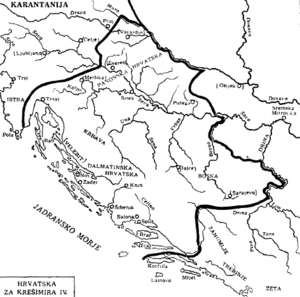
In 788, Pepin of Italy added Istria to the Frankish kingdom. However, the Frankish rule became weaker over time, allowing many towns in Istria to become almost independent.
In the 900s and 1000s, German noble families ruled Istria. Later, it became a separate region called a markgraviate. German emperors gave this land to different noble families. According to some historical records, the eastern parts of Istria, north of the Raša River, belonged to the Croatian Kingdom at that time.
Venetian Influence
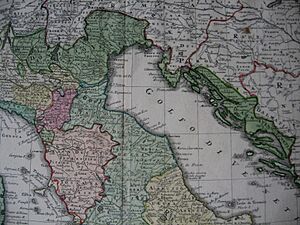
In 1145, the cities of Pula, Koper, and Izola tried to fight against the Republic of Venice but were defeated. Venice then controlled them more closely. During the 1200s, Venice slowly took over more coastal towns in western Istria. By 1348, these wealthy coastal towns officially became part of Venice. Meanwhile, the towns further inland came under the control of the Patriarchate of Aquileia, which later joined the Habsburg Empire in 1374.
Habsburg Empire Rule
The inner part of Istria, around the town of Pazin, was part of the Holy Roman Empire. It was held by the County of Gorizia after the 1100s and passed to the House of Habsburg in 1365. The part of Istria that belonged to Venice also became part of the Habsburg Empire in 1797.
Napoleon's Time
After the fall of the Venetian Republic in 1797, Napoleon took over Istria. He later gave the Venetian parts of Istria to Austria. In 1805, Napoleon re-occupied the former Venetian Istria. From 1805 to 1813, Istria was part of Napoleon's Italian Kingdom and then his Illyrian provinces. For the first time, the inner and eastern parts of Istria became part of Croatia, as set up by Napoleon.
For many centuries, Italian and Slavic communities in Istria lived together peacefully. They often saw themselves simply as "Istrians" with either "Romance" (Italian) or "Slavic" culture.
Austrian Empire and National Identity
From 1814 until 1918, the new Austrian Empire ruled all of Istria. Istria became a separate region, first with Trieste as its capital, then Pazin in 1825. In 1866, Pula became a very important port for the Austrian Navy.
In 1861, a local parliament was created in Poreč. However, only property owners could vote, and most of them were Italian. This meant that Italian calls for Istria to join the newly formed Kingdom of Italy were often heard more loudly.
After 1866, when Italy gained more land from Austria, Istria remained part of the Austro-Hungarian Empire. This led to some Italians in Istria wanting to join Italy. The Austrians, in turn, started to favor the Slavic communities (Slovenes and Croats) in Istria.
In the second half of the 1800s, there was a strong movement for the rights of Croatian and Slovenian people in Istria. Bishop Juraj Dobrila was a leader in this fight for Croatian rights. He wanted to help his people improve their lives and keep their traditions. He also asked for Croatian to become an official language alongside Italian in the Istrian Parliament.
Istria in the 20th Century
After World War I
At the end of First World War, Austria-Hungary was defeated. In 1918, the Italian Royal Army occupied Istria. At the peace conference in Paris, Italy gained control over Istria.
After Fascism came to power in Italy in 1922, the Croatian and Slovene people in Istria faced forced Italianization. This meant their culture and language were suppressed. Croatian schools, cultural groups, and associations were closed, and Croatian names were changed to Italian. Many Croatians moved to the Kingdom of Yugoslavia. An anti-fascist group called TIGR was formed in 1927 and became active in the Slovene and Croatian parts of Istria.
After Italy surrendered in Second World War, Yugoslav Partisans took control of the region. However, Istria was then divided into two zones: Zone A, occupied by Anglo-American forces, and Zone B, managed by Yugoslavia. These zones were later abolished by the Paris Peace Treaties in 1947. During this time, there were sad events like the Foibe massacres, partly caused by the anger of the local non-Italian population due to the previous Italianization. This also led to many Italians leaving Istria, especially from the cities.
Yugoslavia and Independence
According to the Paris Peace Treaty of 1947, the area between Novigrad and Trieste became the independent Free Territory of Trieste. The rest of Istria became part of Yugoslavia. The Free Territory of Trieste was also divided into two zones. Zone A was under Anglo-American control, and Zone B was under Yugoslav military control. Many Italians left Zone B.
In 1954, the Free Territory of Trieste was dissolved. Zone A went to Italy, and the rest of the territory became part of Yugoslavia, divided between Croatia and Slovenia. For the first time, the entire western coast of Istria became part of Croatia. The final border between Italy and Yugoslavia was set in 1975.
After Yugoslavia broke up in 1991, and Croatia and Slovenia became independent countries, Istria was divided along the old republic borders. In 1992, Istria became one of the counties in Croatia. There is still a border dispute between Croatia and Slovenia over the Gulf of Piran area.
See also
- History of Croatia
- History of Slovenia
- History of the Republic of Venice
- History of Italy
- Istria County
- Italianization
- Roman Catholic Diocese of Poreč-Pula



